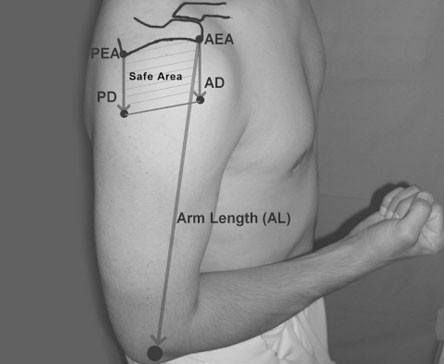Ozgur Cetik, Murad Uslu, Halil Ibrahim Acar, Ayhan Comert, Ibrahim Tekdemir, Hakan Cift
Investigation performed at Department of Orthopaedics and Traumatology, Kirikkale University School of Medicine,
Kirikkale, Turkey, and Department of Anatomy, Ankara University School of Medicine, Ankara, Turkey
Abstract
Background: Several authors have defined a variety of so-called safe zones for deltoid-splitting incisions. The first aim of the present study was to investigate the distance of the axillary nerve from the acromion and its relation to arm length. The second aim was to identify a safe area for the axillary nerve during surgical dissection of the deltoid muscle.
Methods: Twenty-four shoulders of embalmed adult cadavers were included in the study. The distance from the anterior edge of the acromion to the course of the axillary nerve was measured and was recorded as the anterior distance. The same measurement from the posterior edge of the acromion to the course of the axillary nerve was made and was recorded as the posterior distance for each limb. Correlation analysis was performed between the arm length and the anterior distance and the posterior distance for each limb. The ratios between arm length and the anterior and posterior distances were calculated for each case and were recorded as an anterior index and a posterior index.
Results: The average arm length was 30.40 cm. The average anterior distance was 6.08 cm, and the average posterior distance was 4.87 cm. There was a significant correlation between arm length and both anterior distance (r = 0.79, p < 0.001) and posterior distance (r = 0.61, p = 0.001). The axillary nerve was not found to lie at a constant distance from the acromion at every point along its course. The average anterior index was 0.20, and the average posterior index was 0.16.
Conclusions: The present study describes a safe area above the axillary nerve that is quadrangular in shape, with the length of the lateral edges being dependent on the individual’s arm length. Using this safe area should provide a safe exposure for the axillary nerve during shoulder operations.
2006 Nov.

